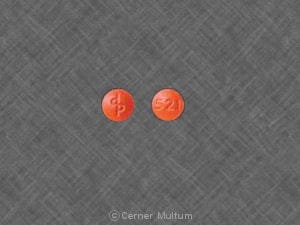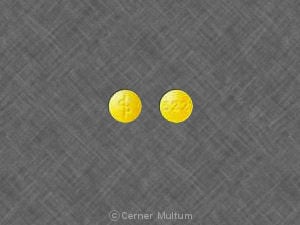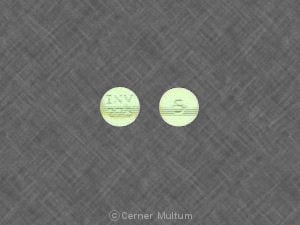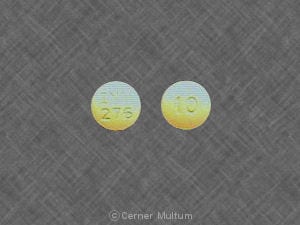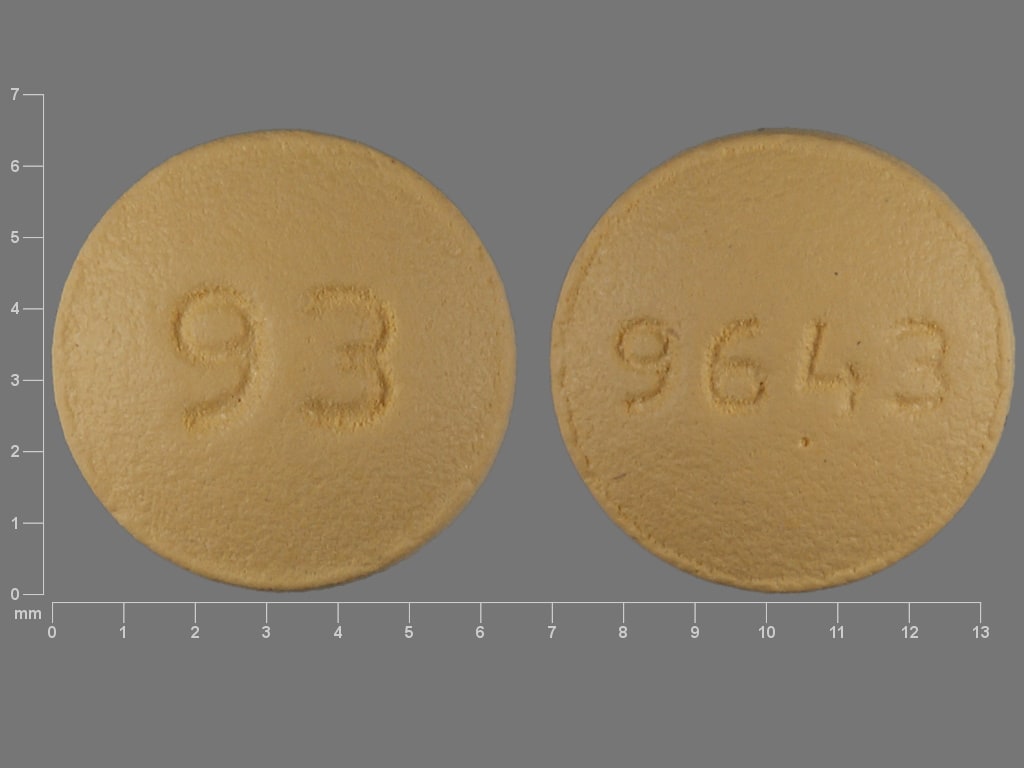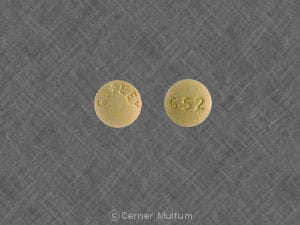Boxed Warning
Dementia:
Elderly patients with dementia-related psychosis treated with antipsychotic drugs are at an increased risk of death. Analyses of 17 placebo-controlled trials (modal duration of 10 weeks), largely in patients taking atypical antipsychotic drugs, revealed a risk of death in drug-treated patients between 1.6 and 1.7 times the risk of death in placebo-treated patients. Over the course of a typical 10-week controlled trial, the rate of death in drug-treated patients was approximately 4.5% compared with a rate of approximately 2.6% in the placebo group. Although the causes of death were varied, most of the deaths appeared to be either cardiovascular (eg, heart failure, sudden death) or infectious (eg, pneumonia) in nature. Observational studies suggest that, similar to atypical antipsychotic drugs, treatment with conventional antipsychotic drugs may increase mortality. The extent to which the findings of increased mortality in observational studies may be attributed to the antipsychotic drug as opposed to some characteristic(s) of the patients is not clear. Prochlorperazine is not approved for the treatment of patients with dementia-related psychosis.
Dosage Forms
Excipient information presented when available (limited, particularly for generics); consult specific product labeling.
Solution, Injection, as edisylate:
Generic: 10 mg/2 mL (2 mL)
Solution, Injection, as edisylate [strength expressed as base]:
Generic: 5 mg/mL (10 mL)
Suppository, Rectal:
Compro: 25 mg (12 ea)
Generic: 25 mg (1 ea, 12 ea, 1000 ea)
Tablet, Oral, as maleate [strength expressed as base]:
Generic: 5 mg, 10 mg
Pharmacology
Mechanism of Action
Prochlorperazine is a piperazine phenothiazine antipsychotic which blocks postsynaptic mesolimbic dopaminergic D1 and D2 receptors in the brain, including the chemoreceptor trigger zone; exhibits a strong alpha-adrenergic and anticholinergic blocking effect and depresses the release of hypothalamic and hypophyseal hormones; believed to depress the reticular activating system, thus affecting basal metabolism, body temperature, wakefulness, vasomotor tone and emesis
Pharmacokinetics/Pharmacodynamics
Distribution
Vd: 1400 to 1548 L (Taylor 1987)
Metabolism
Primarily hepatic; N-desmethyl prochlorperazine (major active metabolite)
Excretion
Mainly in feces
Onset of Action
Oral: 30 to 40 minutes; IM: 10 to 20 minutes; Rectal: ~60 minutes; Peak antiemetic effect: IV: 30 to 60 minutes
Duration of Action
Rectal: 3 to 12 hours; IM, Oral: 3 to 4 hours
Half-Life Elimination
Oral: 6 to 10 hours (single dose), 14 to 22 hours (repeated dosing) (Isah 1991); IV: 6 to 10 hours (Isah 1991; Taylor 1987)
Use: Labeled Indications
Nausea/vomiting: Management of severe nausea and vomiting
Use: Off Label
Nausea and vomiting of pregnancyyes
Based on the American College of Obstetricians and Gynecologists (ACOG) Nausea and Vomiting in Pregnancy guidelines and the Society of Obstetricians and Gynaecologists of Canada (SOGC) Management of Nausea and Vomiting in Pregnancy guidelines, the use of prochlorperazine may be considered for adjunctive treatment of nausea and vomiting in pregnant patients when symptoms persist following initial pharmacologic therapy ACOG 189 2018, Campbell 2016.
Contraindications
Known hypersensitivity to phenothiazines; coma or presence of large amounts of CNS depressants (eg, alcohol, opioids, barbiturates); postoperative management of nausea/vomiting following pediatric surgery; use in infants and children <2 years or <9 kg; pediatric conditions for which dosage has not been established
Documentation of allergenic cross-reactivity for phenothiazines is limited. However, because of similarities in chemical structure and/or pharmacologic actions, the possibility of cross-sensitivity cannot be ruled out with certainty.
Canadian labeling: Additional contraindications (not in the US labeling): Presence of circulatory collapse; severe cardiovascular disorders; altered state of consciousness; concomitant use of high dose hypnotics; severe depression; presence of blood dyscrasias, hepatic or renal impairment, or pheochromocytoma; suspected or established subcortical brain damage with or without hypothalamic damage
Dosage and Administration
Dosing: Adult
Note: Injection solution mesylate formulation is a Canadian product (not available in the US).
Nausea/vomiting:
Oral (tablet): 5 to 10 mg 3 to 4 times/day; usual maximum: 40 mg/day; larger doses may rarely be required for resistant nausea/vomiting
IM (as edisylate): 5 to 10 mg every 3 to 4 hours; maximum dose: 40 mg/day
IM (as mesylate): 5 to 10 mg 2 to 3 times/day; usual maximum: 40 mg/day
IV (as edisylate): 2.5 to 10 mg; maximum: 10 mg/dose or 40 mg/day; may repeat dose every 3 to 4 hours as needed
Rectal: 25 mg twice daily
Canadian product (10 mg suppository): 5 to 10 mg 3 to 4 times/day
Breakthrough chemotherapy-induced nausea and vomiting: IM, IV, Oral: 5 to 10 mg every 4 to 6 hours as needed (Lohr 2008)
Nausea and vomiting due to low emetogenic chemotherapy: 5 to 10 mg IV or orally prior to chemotherapy followed by 5 to 10 mg orally every 6 hours if needed following chemotherapy (Hesketh 2008)
Nausea and vomiting due to minimally emetogenic radiation therapy: IV, Oral: 10 mg (Basch 2011)
Surgical nausea/vomiting: Note: Should not exceed 40 mg/day
IM (as edisylate): 5 to 10 mg 1 to 2 hours before anesthesia induction or to control symptoms during or after surgery; may repeat once in 30 minutes if necessary
IM (as mesylate): 5 to 10 mg 1 to 2 hours before anesthesia induction; may repeat once if needed during surgery; postoperatively: 5 to 10 mg every 3 to 4 hours as needed up to maximum of 40 mg daily
IV (as edisylate): 5 to 10 mg 15 to 30 minutes before anesthesia induction or to control symptoms during or after surgery; may repeat once if necessary
IV (as mesylate): 20 mg/L of IV solution during surgery or postoperatively; usual maximum: 30 mg daily
Rectal: 25 mg (Golembiewski 2005)
Nausea and vomiting of pregnancy (off-label use):
IM, IV, or Oral: 5 to 10 mg every 6 to 8 hours (Campbell 2016)
Rectal: 25 mg every 12 hours (ACOG 189 2018)
Dosing: Geriatric
Initiate at lower end of dosage range; increase dose slowly and cautiously. Refer to adult dosing.
Dosing: Pediatric
Note: Use lowest possible dose in pediatric patients to decrease incidence of extrapyramidal reactions
Chemotherapy-induced nausea and vomiting; refractory, treatment: Limited data available: Note: Due to safety concerns, use of prochlorperazine for breakthrough or refractory CINV is not recommended (Flank 2016; Lau Moon Lin 2016); however, use may be necessary in some patients. Children ≥2 years weighing ≥9 kg and Adolescents:
Oral: 0.1 mg/kg/dose every 6 hours or ~0.3 mg/kg/dose every 8 to 12 hours; maximum dose: 10 mg/dose; maximum daily dose: 40 mg/day (Dupuis 2003; Kliegman 2016)
IV: 0.1 to 0.15 mg/kg/dose every 3 to 4 hours; maximum dose: 10 mg/dose; maximum daily dose: 40 mg/day (Dupuis 2003)
Migraine, intractable: Limited data available: Children ≥7 years and Adolescents: IV (as edisylate): 0.15 mg/kg as a single dose; maximum dose: 10 mg/dose; dosing based on multicenter, prospective, double-blind, randomized ketorolac comparative trial (prochlorperazine group, n=33) and a retrospective review of 92 patients (age range: 7 to 17 years) who received prochlorperazine in combination with diphenhydramine (Brousseau 2004; Trottier 2010)
Nausea and vomiting; severe, treatment: Note: Expert recommendations for postoperative nausea and vomiting (PONV) management do not suggest prochlorperazine as a therapeutic option; use has typically been replaced by newer agents with an improved safety profile (SAA [Gan 2014]; WHO 2011).
Oral:
Fixed dosing: Children ≥2 years weighing ≥9 kg and Adolescents:
9 to 13 kg: 2.5 mg every 12 to 24 hours as needed; maximum daily dose: 7.5 mg/day
>13 to 18 kg: 2.5 mg every 8 to 12 hours as needed; maximum daily dose: 10 mg/day
>18 to 39 kg: 2.5 mg every 8 hours or 5 mg every 12 hours as needed; maximum daily dose: 15 mg/day
>39 kg: 5 to 10 mg every 6 to 8 hours; usual maximum daily dose: 40 mg/day
Weight-directed dosing: Limited data available: Children weighing >10 kg and Adolescents: 0.1 mg/kg/dose every 6 to 8 hours; maximum dose: 10 mg/dose (Wyllie 2016)
Parenteral:
Prochlorperazine edisylate: Limited data available for IV route of administration: Children weighing ≥9 kg and Adolescents: IM (preferred), IV: 0.1 to 0.15 mg/kg/dose; maximum single dose: 10 mg/dose (Wyllie 2016); frequency of administration typically every 8 to 12 hours based upon patient response; convert to oral therapy as soon as possible (Kliegman 2016)
Prochlorperazine mesylate (Canadian product): Children ≥2 years weighing ≥9 kg and Adolescents: IM: 0.14 mg/kg/dose; one dose is usually sufficient; when further doses needed, convert to oral therapy at equivalent or higher dose
Reconstitution
IV infusion: Injection may be diluted in isotonic solution.
Administration
IM: Inject by deep IM into outer quadrant of buttocks. Avoid skin contact with injection solution, contact dermatitis has occurred. Do not administer subcutaneously; may cause local irritation.
IV: May be administered by slow IV push at a rate not exceeding 5 mg/minute or by IV infusion. Do not administer as a bolus injection. To reduce the risk of hypotension, patients receiving IV prochlorperazine must remain lying down and be observed for at least 30 minutes following administration. Avoid skin contact with injection solution, contact dermatitis has occurred. Do not dilute with any diluent containing parabens as a preservative.
Rectal: Do not remove from wrapper until ready to use.
Do not administer subcutaneously; may cause local irritation.
Dietary Considerations
Increase dietary intake of riboflavin; should be administered with food or water. Rectal suppositories may contain coconut and palm oil.
Storage
Injection:
Edisylate: Store at 20°C to 25°C (68°F to 77°F); do not freeze. Protect from light. Clear or slightly yellow solutions may be used.
Mesylate (Canadian product [not available in the US]): Store at 15°C to 30°C (59°F to 86°F). Protect from light. Do not use if solution is discolored or hazy.
Suppository: Store at 20°C to 25°C (68°F to 77°F). Do not remove from wrapper until ready to use.
Tablet: Store at 20°C to 25°C (68°F to 77°F). Protect from light.
Prochlorperazine Images
Drug Interactions
Acetylcholinesterase Inhibitors: May diminish the therapeutic effect of Anticholinergic Agents. Anticholinergic Agents may diminish the therapeutic effect of Acetylcholinesterase Inhibitors. Monitor therapy
Acetylcholinesterase Inhibitors (Central): May enhance the neurotoxic (central) effect of Antipsychotic Agents. Severe extrapyramidal symptoms have occurred in some patients. Monitor therapy
Aclidinium: May enhance the anticholinergic effect of Anticholinergic Agents. Avoid combination
Alcohol (Ethyl): CNS Depressants may enhance the CNS depressant effect of Alcohol (Ethyl). Monitor therapy
Alizapride: May enhance the CNS depressant effect of CNS Depressants. Monitor therapy
Amifampridine: Agents With Seizure Threshold Lowering Potential may enhance the neuroexcitatory and/or seizure-potentiating effect of Amifampridine. Monitor therapy
Aminolevulinic Acid (Systemic): Photosensitizing Agents may enhance the photosensitizing effect of Aminolevulinic Acid (Systemic). Avoid combination
Aminolevulinic Acid (Topical): Photosensitizing Agents may enhance the photosensitizing effect of Aminolevulinic Acid (Topical). Monitor therapy
Amisulpride: Antipsychotic Agents may enhance the adverse/toxic effect of Amisulpride. Management: Drugs listed as exceptions to this monograph are discussed in further detail in separate drug interaction monographs. Avoid combination
Amphetamines: Antipsychotic Agents may diminish the stimulatory effect of Amphetamines. Monitor therapy
Antacids: May decrease the absorption of Antipsychotic Agents (Phenothiazines). Monitor therapy
Anticholinergic Agents: May enhance the adverse/toxic effect of other Anticholinergic Agents. Monitor therapy
Antimalarial Agents: May increase the serum concentration of Antipsychotic Agents (Phenothiazines). Monitor therapy
Anti-Parkinson Agents (Dopamine Agonist): Antipsychotic Agents (First Generation [Typical]) may diminish the therapeutic effect of Anti-Parkinson Agents (Dopamine Agonist). Anti-Parkinson Agents (Dopamine Agonist) may diminish the therapeutic effect of Antipsychotic Agents (First Generation [Typical]). Management: Avoid concomitant therapy if possible and monitor for decreased effects of both agents when these combinations cannot be avoided. Atypical antipsychotics such as clozapine and quetiapine may be less likely to reduce the effects of anti-Parkinson agents. Consider therapy modification
Azelastine (Nasal): CNS Depressants may enhance the CNS depressant effect of Azelastine (Nasal). Avoid combination
Beta-Blockers: Antipsychotic Agents (Phenothiazines) may enhance the hypotensive effect of Beta-Blockers. Beta-Blockers may decrease the metabolism of Antipsychotic Agents (Phenothiazines). Antipsychotic Agents (Phenothiazines) may decrease the metabolism of Beta-Blockers. Exceptions: Atenolol; Levobunolol; Metipranolol; Nadolol. Monitor therapy
Blonanserin: CNS Depressants may enhance the CNS depressant effect of Blonanserin. Consider therapy modification
Botulinum Toxin-Containing Products: May enhance the anticholinergic effect of Anticholinergic Agents. Monitor therapy
Brexanolone: CNS Depressants may enhance the CNS depressant effect of Brexanolone. Monitor therapy
Brimonidine (Topical): May enhance the CNS depressant effect of CNS Depressants. Monitor therapy
Bromopride: May enhance the adverse/toxic effect of Antipsychotic Agents. Avoid combination
Bromperidol: May enhance the CNS depressant effect of CNS Depressants. Avoid combination
Buprenorphine: CNS Depressants may enhance the CNS depressant effect of Buprenorphine. Management: Consider reduced doses of other CNS depressants, and avoiding such drugs in patients at high risk of buprenorphine overuse/self-injection. Initiate buprenorphine at lower doses in patients already receiving CNS depressants. Consider therapy modification
BuPROPion: May enhance the neuroexcitatory and/or seizure-potentiating effect of Agents With Seizure Threshold Lowering Potential. Monitor therapy
Cannabidiol: May enhance the CNS depressant effect of CNS Depressants. Monitor therapy
Cannabis: May enhance the CNS depressant effect of CNS Depressants. Monitor therapy
Chloral Betaine: May enhance the adverse/toxic effect of Anticholinergic Agents. Monitor therapy
Chlormethiazole: May enhance the CNS depressant effect of CNS Depressants. Management: Monitor closely for evidence of excessive CNS depression. The chlormethiazole labeling states that an appropriately reduced dose should be used if such a combination must be used. Consider therapy modification
Chlorphenesin Carbamate: May enhance the adverse/toxic effect of Antipsychotic Agents (Phenothiazines). Monitor therapy
Chlorphenesin Carbamate: May enhance the adverse/toxic effect of CNS Depressants. Monitor therapy
Cimetropium: Anticholinergic Agents may enhance the anticholinergic effect of Cimetropium. Avoid combination
CNS Depressants: May enhance the adverse/toxic effect of other CNS Depressants. Monitor therapy
Deferoxamine: May enhance the adverse/toxic effect of Prochlorperazine. Specifically, prolonged loss of consciousness has been reported. Consider therapy modification
Deutetrabenazine: May enhance the adverse/toxic effect of Antipsychotic Agents. Specifically, the risk for akathisia, parkinsonism, or neuroleptic malignant syndrome may be increased. Monitor therapy
Dimethindene (Topical): May enhance the CNS depressant effect of CNS Depressants. Monitor therapy
Dofetilide: Prochlorperazine may increase the serum concentration of Dofetilide. Avoid combination
Doxylamine: May enhance the CNS depressant effect of CNS Depressants. Management: The manufacturer of Diclegis (doxylamine/pyridoxine), intended for use in pregnancy, specifically states that use with other CNS depressants is not recommended. Monitor therapy
Dronabinol: May enhance the CNS depressant effect of CNS Depressants. Monitor therapy
Droperidol: May enhance the CNS depressant effect of CNS Depressants. Management: Consider dose reductions of droperidol or of other CNS agents (eg, opioids, barbiturates) with concomitant use. Exceptions to this monograph are discussed in further detail in separate drug interaction monographs. Consider therapy modification
Eluxadoline: Anticholinergic Agents may enhance the constipating effect of Eluxadoline. Avoid combination
Esketamine: May enhance the CNS depressant effect of CNS Depressants. Monitor therapy
Flunitrazepam: CNS Depressants may enhance the CNS depressant effect of Flunitrazepam. Consider therapy modification
Gastrointestinal Agents (Prokinetic): Anticholinergic Agents may diminish the therapeutic effect of Gastrointestinal Agents (Prokinetic). Monitor therapy
Glucagon: Anticholinergic Agents may enhance the adverse/toxic effect of Glucagon. Specifically, the risk of gastrointestinal adverse effects may be increased. Monitor therapy
Glycopyrrolate (Oral Inhalation): Anticholinergic Agents may enhance the anticholinergic effect of Glycopyrrolate (Oral Inhalation). Avoid combination
Glycopyrronium (Topical): May enhance the anticholinergic effect of Anticholinergic Agents. Avoid combination
Guanethidine: Antipsychotic Agents may diminish the therapeutic effect of Guanethidine. Monitor therapy
HYDROcodone: CNS Depressants may enhance the CNS depressant effect of HYDROcodone. Management: Avoid concomitant use of hydrocodone and benzodiazepines or other CNS depressants when possible. These agents should only be combined if alternative treatment options are inadequate. If combined, limit the dosages and duration of each drug. Consider therapy modification
HydrOXYzine: May enhance the CNS depressant effect of CNS Depressants. Monitor therapy
Iohexol: Agents With Seizure Threshold Lowering Potential may enhance the adverse/toxic effect of Iohexol. Specifically, the risk for seizures may be increased. Management: Discontinue agents that may lower the seizure threshold 48 hours prior to intrathecal use of iohexol. Wait at least 24 hours after the procedure to resume such agents. In nonelective procedures, consider use of prophylactic anticonvulsants. Consider therapy modification
Iomeprol: Agents With Seizure Threshold Lowering Potential may enhance the adverse/toxic effect of Iomeprol. Specifically, the risk for seizures may be increased. Management: Discontinue agents that may lower the seizure threshold 48 hours prior to intrathecal use of iomeprol. Wait at least 24 hours after the procedure to resume such agents. In nonelective procedures, consider use of prophylactic anticonvulsants. Consider therapy modification
Iopamidol: Agents With Seizure Threshold Lowering Potential may enhance the adverse/toxic effect of Iopamidol. Specifically, the risk for seizures may be increased. Management: Discontinue agents that may lower the seizure threshold 48 hours prior to intrathecal use of iopamidol. Wait at least 24 hours after the procedure to resume such agents. In nonelective procedures, consider use of prophylactic anticonvulsants. Consider therapy modification
Ipratropium (Oral Inhalation): May enhance the anticholinergic effect of Anticholinergic Agents. Avoid combination
Itopride: Anticholinergic Agents may diminish the therapeutic effect of Itopride. Monitor therapy
Kava Kava: May enhance the adverse/toxic effect of CNS Depressants. Monitor therapy
Lemborexant: May enhance the CNS depressant effect of CNS Depressants. Management: Dosage adjustments of lemborexant and of concomitant CNS depressants may be necessary when administered together because of potentially additive CNS depressant effects. Close monitoring for CNS depressant effects is necessary. Consider therapy modification
Levosulpiride: Anticholinergic Agents may diminish the therapeutic effect of Levosulpiride. Avoid combination
Lithium: May enhance the neurotoxic effect of Antipsychotic Agents. Lithium may decrease the serum concentration of Antipsychotic Agents. Specifically noted with chlorpromazine. Monitor therapy
Lofexidine: May enhance the CNS depressant effect of CNS Depressants. Management: Drugs listed as exceptions to this monograph are discussed in further detail in separate drug interaction monographs. Monitor therapy
Magnesium Sulfate: May enhance the CNS depressant effect of CNS Depressants. Monitor therapy
Mequitazine: Antipsychotic Agents may enhance the arrhythmogenic effect of Mequitazine. Management: Consider alternatives to one of these agents when possible. While this combination is not specifically contraindicated, mequitazine labeling describes this combination as discouraged. Consider therapy modification
Methotrimeprazine: CNS Depressants may enhance the CNS depressant effect of Methotrimeprazine. Methotrimeprazine may enhance the CNS depressant effect of CNS Depressants. Management: Reduce adult dose of CNS depressant agents by 50% with initiation of concomitant methotrimeprazine therapy. Further CNS depressant dosage adjustments should be initiated only after clinically effective methotrimeprazine dose is established. Consider therapy modification
Methylphenidate: Antipsychotic Agents may enhance the adverse/toxic effect of Methylphenidate. Methylphenidate may enhance the adverse/toxic effect of Antipsychotic Agents. Monitor therapy
Metoclopramide: May enhance the adverse/toxic effect of Antipsychotic Agents. Avoid combination
MetyroSINE: CNS Depressants may enhance the sedative effect of MetyroSINE. Monitor therapy
MetyroSINE: May enhance the adverse/toxic effect of Antipsychotic Agents. Monitor therapy
Mianserin: May enhance the anticholinergic effect of Anticholinergic Agents. Monitor therapy
Minocycline (Systemic): May enhance the CNS depressant effect of CNS Depressants. Monitor therapy
Mirabegron: Anticholinergic Agents may enhance the adverse/toxic effect of Mirabegron. Monitor therapy
Nabilone: May enhance the CNS depressant effect of CNS Depressants. Monitor therapy
Nitroglycerin: Anticholinergic Agents may decrease the absorption of Nitroglycerin. Specifically, anticholinergic agents may decrease the dissolution of sublingual nitroglycerin tablets, possibly impairing or slowing nitroglycerin absorption. Monitor therapy
Opioid Agonists: CNS Depressants may enhance the CNS depressant effect of Opioid Agonists. Management: Avoid concomitant use of opioid agonists and benzodiazepines or other CNS depressants when possible. These agents should only be combined if alternative treatment options are inadequate. If combined, limit the dosages and duration of each drug. Consider therapy modification
Orphenadrine: CNS Depressants may enhance the CNS depressant effect of Orphenadrine. Avoid combination
Oxatomide: May enhance the anticholinergic effect of Anticholinergic Agents. Avoid combination
Oxomemazine: May enhance the CNS depressant effect of CNS Depressants. Avoid combination
OxyCODONE: CNS Depressants may enhance the CNS depressant effect of OxyCODONE. Management: Avoid concomitant use of oxycodone and benzodiazepines or other CNS depressants when possible. These agents should only be combined if alternative treatment options are inadequate. If combined, limit the dosages and duration of each drug. Consider therapy modification
Paraldehyde: CNS Depressants may enhance the CNS depressant effect of Paraldehyde. Avoid combination
Perampanel: May enhance the CNS depressant effect of CNS Depressants. Management: Patients taking perampanel with any other drug that has CNS depressant activities should avoid complex and high-risk activities, particularly those such as driving that require alertness and coordination, until they have experience using the combination. Consider therapy modification
Piribedil: Antipsychotic Agents may diminish the therapeutic effect of Piribedil. Piribedil may diminish the therapeutic effect of Antipsychotic Agents. Management: Use of piribedil with antiemetic neuroleptics is contraindicated, and use with antipsychotic neuroleptics, except for clozapine, is not recommended. Avoid combination
Porfimer: Photosensitizing Agents may enhance the photosensitizing effect of Porfimer. Monitor therapy
Potassium Chloride: Anticholinergic Agents may enhance the ulcerogenic effect of Potassium Chloride. Management: Patients on drugs with substantial anticholinergic effects should avoid using any solid oral dosage form of potassium chloride. Avoid combination
Potassium Citrate: Anticholinergic Agents may enhance the ulcerogenic effect of Potassium Citrate. Avoid combination
Pramlintide: May enhance the anticholinergic effect of Anticholinergic Agents. These effects are specific to the GI tract. Consider therapy modification
Quinagolide: Antipsychotic Agents may diminish the therapeutic effect of Quinagolide. Monitor therapy
Ramosetron: Anticholinergic Agents may enhance the constipating effect of Ramosetron. Monitor therapy
Revefenacin: Anticholinergic Agents may enhance the anticholinergic effect of Revefenacin. Avoid combination
Rufinamide: May enhance the adverse/toxic effect of CNS Depressants. Specifically, sleepiness and dizziness may be enhanced. Monitor therapy
Saquinavir: Antipsychotic Agents (Phenothiazines) may enhance the arrhythmogenic effect of Saquinavir. Management: Drugs listed as exceptions to this monograph are discussed in further detail in separate drug interaction monographs. Avoid combination
Secretin: Anticholinergic Agents may diminish the therapeutic effect of Secretin. Management: Avoid concomitant use of anticholinergic agents and secretin. Discontinue anticholinergic agents at least 5 half-lives prior to administration of secretin. Consider therapy modification
Selective Serotonin Reuptake Inhibitors: CNS Depressants may enhance the adverse/toxic effect of Selective Serotonin Reuptake Inhibitors. Specifically, the risk of psychomotor impairment may be enhanced. Monitor therapy
Serotonergic Agents (High Risk): May enhance the adverse/toxic effect of Antipsychotic Agents. Specifically, serotonergic agents may enhance dopamine blockade, possibly increasing the risk for neuroleptic malignant syndrome. Antipsychotic Agents may enhance the serotonergic effect of Serotonergic Agents (High Risk). This could result in serotonin syndrome. Monitor therapy
Serotonin Reuptake Inhibitor/Antagonists: Antipsychotic Agents (Phenothiazines) may enhance the adverse/toxic effect of Serotonin Reuptake Inhibitor/Antagonists. Specifically, this may be manifest as symptoms consistent with serotonin syndrome or neuroleptic malignant syndrome. Serotonin Reuptake Inhibitor/Antagonists may enhance the hypotensive effect of Antipsychotic Agents (Phenothiazines). Monitor therapy
Sodium Oxybate: May enhance the CNS depressant effect of CNS Depressants. Management: Consider alternatives to combined use. When combined use is needed, consider minimizing doses of one or more drugs. Use of sodium oxybate with alcohol or sedative hypnotics is contraindicated. Consider therapy modification
Sulpiride: Antipsychotic Agents may enhance the adverse/toxic effect of Sulpiride. Avoid combination
Suvorexant: CNS Depressants may enhance the CNS depressant effect of Suvorexant. Management: Dose reduction of suvorexant and/or any other CNS depressant may be necessary. Use of suvorexant with alcohol is not recommended, and the use of suvorexant with any other drug to treat insomnia is not recommended. Consider therapy modification
Tapentadol: May enhance the CNS depressant effect of CNS Depressants. Management: Avoid concomitant use of tapentadol and benzodiazepines or other CNS depressants when possible. These agents should only be combined if alternative treatment options are inadequate. If combined, limit the dosages and duration of each drug. Consider therapy modification
Tetrabenazine: May enhance the adverse/toxic effect of Antipsychotic Agents. Monitor therapy
Tetrahydrocannabinol: May enhance the CNS depressant effect of CNS Depressants. Monitor therapy
Tetrahydrocannabinol and Cannabidiol: May enhance the CNS depressant effect of CNS Depressants. Monitor therapy
Thalidomide: CNS Depressants may enhance the CNS depressant effect of Thalidomide. Avoid combination
Thiazide and Thiazide-Like Diuretics: Anticholinergic Agents may increase the serum concentration of Thiazide and Thiazide-Like Diuretics. Monitor therapy
Thiopental: Antipsychotic Agents (Phenothiazines) may enhance the adverse/toxic effect of Thiopental. Monitor therapy
Tiotropium: Anticholinergic Agents may enhance the anticholinergic effect of Tiotropium. Avoid combination
Topiramate: Anticholinergic Agents may enhance the adverse/toxic effect of Topiramate. Monitor therapy
Trimeprazine: May enhance the CNS depressant effect of CNS Depressants. Monitor therapy
Umeclidinium: May enhance the anticholinergic effect of Anticholinergic Agents. Avoid combination
Verteporfin: Photosensitizing Agents may enhance the photosensitizing effect of Verteporfin. Monitor therapy
Zolpidem: CNS Depressants may enhance the CNS depressant effect of Zolpidem. Management: Reduce the Intermezzo brand sublingual zolpidem adult dose to 1.75 mg for men who are also receiving other CNS depressants. No such dose change is recommended for women. Avoid use with other CNS depressants at bedtime; avoid use with alcohol. Consider therapy modification
Test Interactions
False-positives for phenylketonuria, pregnancy
Adverse Reactions
Frequency not defined. Reactions listed are based on reports for other agents in this same pharmacologic class and may not be specifically reported for prochlorperazine.
Cardiovascular: ECG abnormality (Q wave and T wave distortions), hypotension, peripheral edema
Central nervous system: Agitation, altered cerebrospinal proteins, catatonia, cerebral edema, coma, decreased cough reflex, disruption of body temperature regulation, dizziness, drowsiness, dystonia (carpopedal spasm, protrusion of tongue, torticollis, trismus), extrapyramidal reaction (akathisia, dystonias, hyperreflexia, pseudoparkinsonism, tardive dyskinesia), headache, hyperpyrexia, insomnia, jitteriness, neuroleptic malignant syndrome (NMS), opisthotonos, restlessness, seizure
Dermatologic: Contact dermatitis, diaphoresis, erythema, eczema, exfoliative dermatitis, pruritus, skin photosensitivity, skin changes, skin pigmentation, urticaria
Endocrine & metabolic: Amenorrhea, change in libido, galactorrhea, gynecomastia, glycosuria, hyperglycemia, hypoglycemia, menstrual disease, weight gain
Gastrointestinal: Atony of colon, cholestasis, increased appetite, constipation, intestinal obstruction, nausea, obstipation, vomiting, xerostomia
Genitourinary: Ejaculatory disorder, impotence, lactation, priapism, urinary retention
Hematologic & oncologic: Agranulocytosis, aplastic anemia, eosinophilia, hemolytic anemia, immune thrombocytopenia, leukopenia, pancytopenia
Hepatic: Cholestatic jaundice, hepatotoxicity
Hypersensitivity: Anaphylactoid reaction, angioedema, hypersensitivity reaction
Infection: Infection
Neuromuscular & skeletal: Lupus-like syndrome, tremor
Ophthalmic: Blurred vision, cataract, epithelial keratopathy, corneal deposits, miosis, mydriasis, oculogyric crisis, retinitis pigmentosa
Respiratory: Asphyxia, asthma, laryngeal edema, nasal congestion
Miscellaneous: Fever (mild; intramuscular administration)
Warnings/Precautions
Concerns related to adverse effects:
- Altered cardiac conduction: May alter cardiac conduction (life-threatening arrhythmias have occurred with therapeutic doses of phenothiazines).
- Anticholinergic effects: May cause anticholinergic effects (constipation, xerostomia, blurred vision, urinary retention); use with caution in patients with decreased gastrointestinal motility, paralytic ileus, urinary retention, BPH, xerostomia, or visual problems.
- Aspiration of vomit: Aspiration of vomit has occurred in postsurgical patients who have received prochlorperazine as an antiemetic (case reports). Although no causal relationship has been established, this possibility should be considered during post-surgical care.
- Blood dyscrasias: Leukopenia, neutropenia, and agranulocytosis (sometimes fatal) have been reported in clinical trials and postmarketing reports with antipsychotic use; presence of risk factors (eg, preexisting low WBC or history of drug-induced leuko-/neutropenia) should prompt periodic blood count assessment. Discontinue therapy at first signs of blood dyscrasias or if absolute neutrophil count <1,000/mm3.
- CNS depression: May cause CNS depression, which may impair physical or mental abilities; patients must be cautioned about performing tasks that require mental alertness (eg, operating machinery or driving).
- Esophageal dysmotility/Aspiration: Antipsychotic use has been associated with esophageal dysmotility and aspiration; risks increase with age. Use with caution in patients at risk for aspiration pneumonia (ie, Alzheimer disease), particularly in patients >75 years (Herzig 2017; Maddalena 2004).
- Extrapyramidal symptoms: May cause extrapyramidal symptoms (EPS), including pseudoparkinsonism, acute dystonic reactions, akathisia, and tardive dyskinesia. Risk of dystonia (and possibly other EPS) may be greater with increased doses, use of conventional antipsychotics, males, and younger patients. Factors associated with greater vulnerability to tardive dyskinesia include older in age, female gender combined with postmenopausal status, Parkinson disease, pseudoparkinsonism symptoms, affective disorders (particularly major depressive disorder), concurrent medical diseases such as diabetes, previous brain damage, alcoholism, poor treatment response, and use of high doses of antipsychotics (APA [Lehman 2004]; Soares-Weisner 2007). Consider therapy discontinuation with signs/symptoms of tardive dyskinesia.
- Falls: May increase the risk for falls due to somnolence, orthostatic hypotension and motor or sensory instability. Assess fall risk at baseline and periodically during treatment in patients with diseases, conditions, or on medications that may increase fall risk.
- Hyperprolactinemia: Use associated with increased prolactin levels; clinical significance of hyperprolactinemia in patients with breast cancer or other prolactin-dependent tumors is unknown.
- Hypotension: May occur following administration, particularly when parenteral form is used or in high dosages. May cause orthostatic hypotension; use with caution in patients at risk of this effect or in those who would not tolerate transient hypotensive episodes (cerebrovascular disease, cardiovascular disease, hypovolemia, or concurrent medication use which may predispose to hypotension/bradycardia).
- Neuroleptic malignant syndrome (NMS): May be associated with NMS; monitor for mental status changes, fever, muscle rigidity, and/or autonomic instability.
- Ocular effects: May cause pigmentary retinopathy, and lenticular and corneal deposits, particularly with prolonged therapy.
- Temperature regulation: Impaired core body temperature regulation may occur; caution with strenuous exercise, heat exposure, dehydration, and concomitant medication possessing anticholinergic effects.
Disease-related concerns:
- Cardiovascular disease: Use with caution in patients with severe cardiovascular disease.
- Dementia: [US Boxed Warning]: Elderly patients with dementia-related psychosis treated with antipsychotic drugs are at an increased risk of death compared with placebo. Most deaths appeared to be either cardiovascular (eg, heart failure, sudden death) or infectious (eg, pneumonia) in nature. Use with caution in patients with Lewy body dementia or Parkinson disease dementia due to greater risk of adverse effects, increased sensitivity to extrapyramidal effects, and association with irreversible cognitive decompensation or death. The APA recommends giving preference to second generation antipsychotics over first generation antipsychotics in elderly patients with dementia-related psychosis due to a potentially greater risk of harm relative to second generation antipsychotics (APA [Reus 2016]). Prochlorperazine is not approved for the treatment of dementia-related psychosis.
- Hepatic impairment: Use with caution in patients with hepatic impairment.
- Renal impairment: Use with caution in patients with renal impairment.
- Reye’s syndrome: Avoid use in patients with signs/symptoms suggestive of Reye syndrome.
- Seizure disorder: Use with caution in patients at risk of seizures, including those with a history of seizures, head trauma, brain damage, alcoholism, or concurrent therapy with medications which may lower seizure threshold.
Concurrent drug therapy issues:
- Drug-drug interactions: Potentially significant interactions may exist, requiring dose or frequency adjustment, additional monitoring, and/or selection of alternative therapy. Consult drug interactions database for more detailed information.
Special populations:
- Pediatric patients: Although FDA approved, other contemporary therapies have replaced the use of prochlorperazine in the management of psychotic disorders (including schizophrenia). Treatment guidelines do not include prochlorperazine as a recommended therapy in the management of schizophrenia in pediatric or adult patients (AACAP [McClellan 2013]; APA [Lehman 2004]; WFSBP [Hasan 2012]).
Dosage form specific issues:
- Benzyl alcohol and derivatives: Some dosage forms may contain benzyl alcohol; large amounts of benzyl alcohol (≥99 mg/kg/day) have been associated with a potentially fatal toxicity (“gasping syndrome”) in neonates; the “gasping syndrome” consists of metabolic acidosis, respiratory distress, gasping respirations, CNS dysfunction (including convulsions, intracranial hemorrhage), hypotension, and cardiovascular collapse (AAP ["Inactive" 1997]; CDC 1982); some data suggests that benzoate displaces bilirubin from protein binding sites (Ahlfors 2001); avoid or use dosage forms containing benzyl alcohol with caution in neonates. See manufacturer’s labeling.
- Sodium sulfite: Some dosage forms may contain sodium sulfite.
Monitoring Parameters
Mental status; vital signs (as clinically indicated); weight, height, BMI, waist circumference (baseline; at every visit for the first 6 months; quarterly with stable antipsychotic dose); CBC (as clinically indicated; monitor frequently during the first few months of therapy in patients with preexisting low WBC or history of drug-induced leukopenia/neutropenia); electrolytes and liver function (annually and as clinically indicated); fasting plasma glucose level/HbA1c (baseline, then yearly; in patients with diabetes risk factors or if gaining weight repeat 4 months after starting antipsychotic, then yearly); lipid panel (baseline; repeat every 2 years if LDL level is normal; repeat every 6 months if LDL level is >130 mg/dL); changes in menstruation, libido, development of galactorrhea, erectile and ejaculatory function (at each visit for the first 12 weeks after the antipsychotic is initiated or until the dose is stable, then yearly); abnormal involuntary movements or parkinsonian signs (baseline; repeat weekly until dose stabilized for at least 2 weeks after introduction and for 2 weeks after any significant dose increase); tardive dyskinesia (every 6 months; high-risk patients every 3 months); visual changes (inquire yearly); ocular examination (yearly in patients >40 years; every 2 years in younger patients) (ADA 2004; Lehman 2004; Marder 2004).
Pregnancy
Pregnancy Considerations
Jaundice or hyper- or hyporeflexia have been reported in newborn infants following maternal use of phenothiazines. Antipsychotic use during the third trimester of pregnancy has a risk for abnormal muscle movements (extrapyramidal symptoms [EPS]) and withdrawal symptoms in newborns following delivery. Symptoms in the newborn may include agitation, feeding disorder, hypertonia, hypotonia, respiratory distress, somnolence, and tremor; these effects may be self-limiting or require hospitalization.
The use of prochlorperazine may be considered for adjunctive treatment of nausea and vomiting in pregnant patients when symptoms persist following initial pharmacologic therapy (ACOG 189 2018).
Use may interfere with pregnancy tests, causing false positive results.
Patient Education
What is this drug used for?
- It is used to treat anxiety.
- It is used to treat upset stomach and throwing up.
- It is used to treat schizophrenia.
- It may be given to you for other reasons. Talk with the doctor.
Frequently reported side effects of this drug
- Anxiety
- Constipation
- Dry mouth
- Fatigue
Other side effects of this drug: Talk with your doctor right away if you have any of these signs of:
- Infection
- Liver problems like dark urine, fatigue, lack of appetite, nausea, abdominal pain, light-colored stools, vomiting, or yellow skin.
- Abnormal movements
- Twitching
- Change in balance
- Difficulty speaking
- Difficulty swallowing
- Severe dizziness
- Passing out
- Chest pain
- Fast heartbeat
- Abnormal heartbeat
- Confusion
- Mood changes
- Agitation
- Trouble sleeping
- Seizures
- Tremors
- Difficulty moving
- Rigidity
- Drooling
- Swelling of arms or legs
- Vision changes
- Bruising
- Bleeding
- Unable to pass urine
- Severe loss of strength and energy
- Enlarged breasts
- Nipple discharge
- Sexual dysfunction
- No menstrual periods
- Neuroleptic malignant syndrome like fever, muscle cramps or stiffness, dizziness, severe headache, confusion, change in thinking, fast heartbeat, abnormal heartbeat, or sweating a lot.
- Tardive dyskinesia like unable to control body movements; tongue, face, mouth, or jaw sticking out; mouth puckering; or puffing cheeks.
- Signs of a significant reaction like wheezing; chest tightness; fever; itching; bad cough; blue skin color; seizures; or swelling of face, lips, tongue, or throat.
Note: This is not a comprehensive list of all side effects. Talk to your doctor if you have questions.
Consumer Information Use and Disclaimer: This information should not be used to decide whether or not to take this medicine or any other medicine. Only the healthcare provider has the knowledge and training to decide which medicines are right for a specific patient. This information does not endorse any medicine as safe, effective, or approved for treating any patient or health condition. This is only a brief summary of general information about this medicine. It does NOT include all information about the possible uses, directions, warnings, precautions, interactions, adverse effects, or risks that may apply to this medicine. This information is not specific medical advice and does not replace information you receive from the healthcare provider. You must talk with the healthcare provider for complete information about the risks and benefits of using this medicine.
